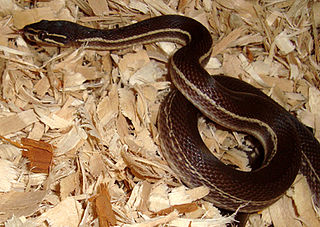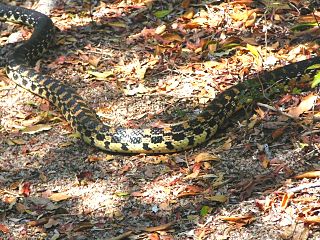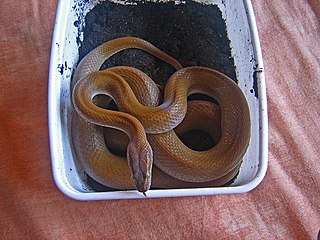
Aspidelaps is a genus of venomous elapid snakes endemic to Africa. Species in the genus Aspidelaps are commonly called shield-nosed cobras, African coral snakes or coral cobras after their cobra hoods and enlarged rostral (nose) scales. However, the hood is not nearly as well developed in Aspidelaps as it is in the true cobras of the genus Naja.

Lamprophis is a genus of medium-sized, nonvenomous snakes commonly referred to as African house snakes, in the family Lamprophiidae.
Hormonotus is a genus of snakes. At present, this genus is monotypic, as there is only one commonly accepted species in it, Hormonotus modestus, commonly known as the Uganda house snake or yellow forest snake. It is widespread in tropical Africa. Its sister taxon is Inyoka swazicus, the Swazi rock snake.
Mehelya is a genus name of snakes native to Africa. Some species formerly assigned to the genus Mehelya are now found in the genera Gonionotophis, Gracililima, or Limaformosa. They are collectively called file snakes due to their unusual scalation. They are not venomous.

Lycodonomorphus is a genus of snakes commonly referred to as African water snakes. They are small, nonvenomous snakes, with all members being endemic to Africa, especially Tanzania.

The Cape file snake is a species of large, non-venomous snake endemic to Africa, belonging to the family Lamprophiidae.

Boaedon is a genus of African lamprophiids consisting of the "brown" house snakes. The genus was originally described by Duméril but the species contained were reclassified as Lamprophis by Fitzinger in 1843, this taxonomy remained widely accepted until November 2010 when a phylogenetic study was published by C.M.R Kelly et al. who resurrected the Boaedon clade. Although commonly regarded as belonging to the Colubridae, primary literature usually lists them and related species as belonging to the family Lamprophiidae within the superfamily Elapoidea, which includes the venomous cobras and mambas.
Inyoka is a monotypic genus of southern African snakes. The word "inyoka" means "snake" in Zulu, Xhosa, Swahili, Shona and other African languages. These snakes were previously grouped in the genus Lamprophis but were found to be closer related to Hormonotus; a substantial genetic divergence between them and a 1900 km gap between their geographic ranges meant a new genus was erected for Lamprophis swazicus, the sole species of the new genus.

Leioheterodon geayi, commonly known as Geay's hognose snake, the Madagascan speckled hognose snake, and the speckled hognose snake, is a species of mildly venomous snake in the family Lamprophiidae. The species is native to southwestern Madagascar.

The Lamprophiidae are a family of snakes found throughout much of Africa, including Seychelles. There are 89 species as of July 2022.

Hemirhagerrhis is a genus of snakes in the family Psammophiidae.

Prosymna is a genus of elapoid snake. It is the only genus in the family Prosymnidae. They were formerly placed as a subfamily of the Lamprophiidae, but have been more recently identified as a distinct family.

Lamprophiinae is a subfamily of lamprophiid snakes, a large group of mostly African snakes, most of which were formerly classified as colubrids but which we now know are actually more closely related to elapids.

Lycodonomorphus inornatus, commonly known as the olive house snake, the black house snake, and the olive ground snake, is a species of nonvenomous snake in the family Lamprophiidae. The species is endemic to southern Africa. It is a nocturnal snake with terrestrial habits.
Hydrablabes is a genus of snakes in the subfamily Natricinae of the family Colubridae. The genus contains two species.

The black file snake, also known commonly as the dwarf file snake or the Nyassa file snake, is a species of snake in the subfamily Lamprophiinae of the family Lamprophiidae. The species is endemic to Africa.

Limaformosa is a genus of snakes, commonly known as file snakes, in the family Lamprophiidae. The genus is endemic to Africa.
Kladirostratus is a genus of snakes of the family Lamprophiidae. Members of this genus are known as Branch's beaked snakes.












